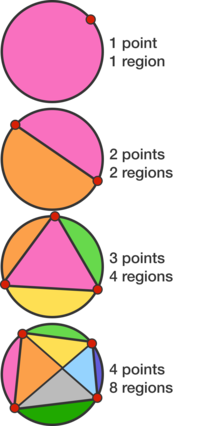Points and regions

Select a number of points along the circumference of a circle and connect each pair with a chord. These chords will divide the interior of the circle into a number of regions.
The maximum numbers of regions are shown at right for 1 to 4 points.
What is the maximum number of regions for six points?
This section requires Javascript.
You are seeing this because something didn't load right. We suggest you, (a) try
refreshing the page, (b) enabling javascript if it is disabled on your browser and,
finally, (c)
loading the
non-javascript version of this page
. We're sorry about the hassle.
This is a classic problem demonstrating the dangers of inductive reasoning, because although it appears that the maximum number of regions R and the the number of points along the circumference of the circle n are related by the equation R = 2 n − 1 , it is actually related by the equation R = 1 + ( 2 n ) + ( 4 n ) , 1 for the starting region of the circle, ( 2 n ) for the number of possible chords that can be drawn (each new chord adds a new region), and ( 4 n ) for the number of possible quadrilaterals that can be drawn (each new quadrilateral has two intersecting diagonals that adds a new region).
For n = 6 points, the maximum number of regions is therefore R = 1 + ( 2 6 ) + ( 4 6 ) = 1 + 1 5 + 1 5 = 3 1 , as illustrated below.